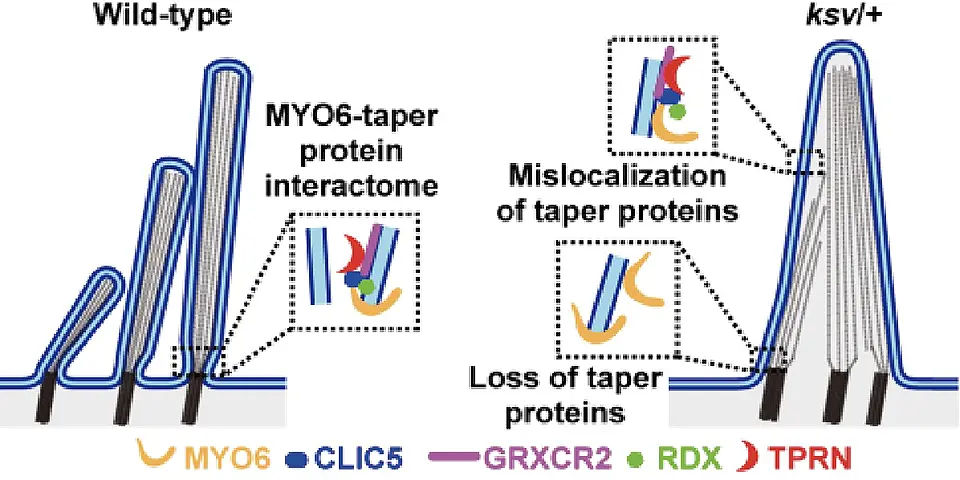
- HOME
- Deafness Project
Deafness Project
Advancing therapies through functional characterization of hearing loss-associated genes
Achievements in 2024
An unconventional myosin, myosin VI gene (MYO6), contributes to recessive and dominant hearing loss in humans and mice. The Kumamoto shaker/waltzer (ksv) mouse is a model of deafness resulting from a splice-site mutation in Myo6 (PLoS One, 2017). While ksv/ksv homozygous mice are deaf due to cochlear hair cell stereocilia fusion at the neonatal stage, the hearing phenotypes of ksv/+ heterozygous mice have been less clear. Due to this splicing error, most MYO6 protein expression is lost in ksv mice; however, MYO6 with a single amino acid mutation (p.E461K) remains expressed. In this study, we investigated the hearing phenotypes and effect of a p.E461K mutation in ksv/+ heterozygous mice. Hearing tests indicated that hearing loss in ksv/+ mice arises concurrently at both low and high frequencies (Exp Anim, in press). In the low-frequency region, stereocilia fusions were detected in the inner hair cells of ksv/+ mice.
Expression analysis revealed abnormal MYO6 expression and localization, along with atypical expression of proteins in the basal region of the stereocilia, suggesting that these abnormalities may contribute to stereocilia fusion in ksv/+ mice. Conversely, although the expression patterns of MYO6 and stereociliary basal-region proteins appeared normal in the cochlear area corresponding to high-frequency sounds, stereocilia loss was observed in ksv/+ mice. These findings suggest that the ksv/+ mice exhibit distinct mechanisms underlying hearing loss across areas responsible for low- and high-frequency hearing, differing from those previously reported in heterozygous Myo6 mice with loss-of-function (Neuroscience 2021) and missense mutant alleles.

Publications
Papers in 2024
- Seki Y, et al. “Dominant effect of a single amino acid mutation in the motor domain of myosin VI on hearing in mice.” Exp. Anim. in press
- Mutai H, et al. “Genetic landscape in undiagnosed patients with syndromic hearing loss revealed by whole exome sequencing and phenotype similarity search.” Hum. Genet. in press
- Fukuda M, et al. (2024) “Protein profile of mouse endolymph suggests a role in controlling cochlear homeostasis.” iScience 27, 111214.
Key papers
- Seki Y, et al. (2021) “Myosin VI haploinsufficiency reduced hearing ability in mice.” Neuroscience. 478:100-111.
- Seki Y, et al. (2017) “A novel splice site mutation of myosin VI in mice leads to stereociliary fusion caused by disruption of actin networks in the apical region of inner ear hair cells.” PLoS One 12, e0183477.

